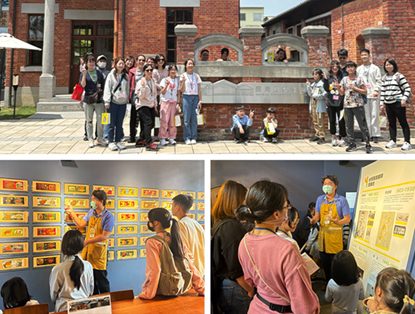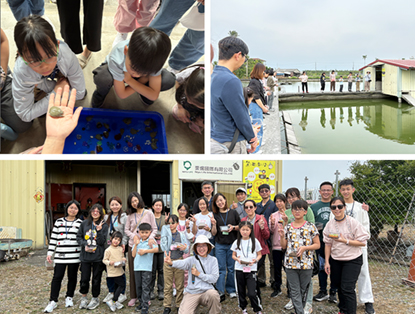Sketch of Archilife Study Tour, March 2025
|
2025年3月份見識之旅縮影  2025年3月30日由呂明澐小姐帶領22位見習生及其家長們,至高屏進行臺灣鳳梨暨鱉出來沒探索之旅。高雄大樹一帶因物候條件適合鳳梨生長成為主要產區之一,日治時期大稻埕的泰芳商會亦於大樹設立多座「鳳梨罐詰工場」經營生產,而上午首站眾人所參訪的「臺灣鳳梨工場」,正是全臺僅存的日治時期鳳梨罐頭產業歷史建築活化再利用。導覽員首先引領大家園區草坪佇足,介紹現場種植的多種鮮食鳳梨品種,然而較適合加工做成罐頭的,其實源於日治時期由夏威夷引進果實頭尾直徑略等的「開英種」,不但利於自動機械削皮量產,加上其纖維較粗、罐頭製作加熱過程中果肉組織不易鬆散;隨後步入館內參觀,最吸引眾人目光的便是滿滿掛列72張鳳梨罐頭標籤藝術裱框的牆面,乍看構圖類似,細看卻有不同的祥瑞動植物或風土人物圖案,呼應著導覽員講述1902年以來,臺灣鳳梨罐頭產業的發展、競爭、頂盛到外移的變遷史,而透過鎮館之寶—復刻日治時期的封罐機,讓大家完成標籤紙彩繪DIY,為曾經風靡一時的鳳梨罐頭品牌標誌們增添個人創意。 2025年3月30日由呂明澐小姐帶領22位見習生及其家長們,至高屏進行臺灣鳳梨暨鱉出來沒探索之旅。高雄大樹一帶因物候條件適合鳳梨生長成為主要產區之一,日治時期大稻埕的泰芳商會亦於大樹設立多座「鳳梨罐詰工場」經營生產,而上午首站眾人所參訪的「臺灣鳳梨工場」,正是全臺僅存的日治時期鳳梨罐頭產業歷史建築活化再利用。導覽員首先引領大家園區草坪佇足,介紹現場種植的多種鮮食鳳梨品種,然而較適合加工做成罐頭的,其實源於日治時期由夏威夷引進果實頭尾直徑略等的「開英種」,不但利於自動機械削皮量產,加上其纖維較粗、罐頭製作加熱過程中果肉組織不易鬆散;隨後步入館內參觀,最吸引眾人目光的便是滿滿掛列72張鳳梨罐頭標籤藝術裱框的牆面,乍看構圖類似,細看卻有不同的祥瑞動植物或風土人物圖案,呼應著導覽員講述1902年以來,臺灣鳳梨罐頭產業的發展、競爭、頂盛到外移的變遷史,而透過鎮館之寶—復刻日治時期的封罐機,讓大家完成標籤紙彩繪DIY,為曾經風靡一時的鳳梨罐頭品牌標誌們增添個人創意。 For the study tour of March 30, 2025, Ms. Lu Ming-yun led 22 ARF interns and their parents on a trip to Gaoping to explore Taiwan pineapples and softshell turtles. Dashu, Kaohsiung, was a main production area for pineapples due to its climate conditions. During the Japanese Occupation, many pineapple canning factories were built by the Taifang Chamber of Commerce. The Taiwan Pineapple Museum, the first stop on the tour, was the only remaining historical building from the pineapple canning industry of that era that had been revitalized. Observing different varieties of edible pineapple, everyone learned that the Cayenne variety, which came from Hawaii during the Japanese Occupation, was suitable for canning. Its mostly equal diameters at the top and bottom made it conducive to automated peeling, and its rougher fibers prevented its flesh from scattering easily during the heating process. Within the museum, the most striking display was a wall framing 72 pineapple-can labels depicting different auspicious plants, animals, and folk characters. They have encapsulated the transformation of the Taiwan pineapple canning industry since 1902, from its development, competition, and peak growth to offshoring. Using a canning machine replica, everyone painted their own creative can labels. For the study tour of March 30, 2025, Ms. Lu Ming-yun led 22 ARF interns and their parents on a trip to Gaoping to explore Taiwan pineapples and softshell turtles. Dashu, Kaohsiung, was a main production area for pineapples due to its climate conditions. During the Japanese Occupation, many pineapple canning factories were built by the Taifang Chamber of Commerce. The Taiwan Pineapple Museum, the first stop on the tour, was the only remaining historical building from the pineapple canning industry of that era that had been revitalized. Observing different varieties of edible pineapple, everyone learned that the Cayenne variety, which came from Hawaii during the Japanese Occupation, was suitable for canning. Its mostly equal diameters at the top and bottom made it conducive to automated peeling, and its rougher fibers prevented its flesh from scattering easily during the heating process. Within the museum, the most striking display was a wall framing 72 pineapple-can labels depicting different auspicious plants, animals, and folk characters. They have encapsulated the transformation of the Taiwan pineapple canning industry since 1902, from its development, competition, and peak growth to offshoring. Using a canning machine replica, everyone painted their own creative can labels.午後前往屏東內埔,探索另一項在地特色產業「鱉」的生態與養殖。首先抵達的是當地頗具規模的鱉類養殖場,由養殖園主帶領大家近距離觀察觸碰小鱉,生動地講解龜與鱉的差異,並介紹鱉在水質、水溫與飼養環境上的嚴格需求。稍後來到養殖區餵食成鱉,從池畔觀察牠們害羞的天性,只有在大家靜止不動、保持安靜時,鱉才會小心翼翼地探出頭來,啄食水面上的飼料,十分有趣。隨後移動至產蛋室,近距離觀看鱉蛋,並安排見習生們在模擬鱉的產蛋環境中,挖掘由保麗龍仿製、尺寸相同的鱉蛋,提供兼具趣味與體驗的互動活動。最後進行鱉蛋孵化盒布置DIY,讓大家可以在返家後更了解小鱉的孵育與飼養方式。參觀過程中,除了生態觀察,養殖園主也分享了養鱉產業面臨的挑戰與轉型,包括市場需求變動、環保法規趨嚴等外部壓力,促使業者思考轉向觀光體驗與教育推廣的可能性。透過實地走訪,見習生們不僅對鱉的養殖知識有初步理解,也對地方產業如何因應時代變遷、結合文化與教育進行創新,有了更深刻的體會。  In the afternoon, everyone explored another specialty industry – farming of softshell turtles in Neipu, Pingtung. At a farm, everyone met and touched baby softshell turtles, and learned about the differences between turtles and softshell turtles, as well as strict requirements for water quality, temperature, and feeding environment. In the feeding area for mature softshell turtles, shy softshell turtles would only stick out their heads to feed when everyone was still and quiet. After observing softshell turtle eggs up close in the hatchery, everyone had fun digging for polystyrene eggs in a simulated environment. In the DIY session, everyone decorated incubation boxes, which were brought home for further understanding of softshell turtle hatching and feeding. The farm owner also shared challenges faced and transformation of the softshell turtle farming industry, including how changes in market demand and stricter environmental laws and regulations prompted business operators to consider the possibility of experiential tourism and educational programs. Through the visit, interns gained a little insight into softshell turtle farming, and realized how local industries responded to changing times and innovated by combining culture and education. In the afternoon, everyone explored another specialty industry – farming of softshell turtles in Neipu, Pingtung. At a farm, everyone met and touched baby softshell turtles, and learned about the differences between turtles and softshell turtles, as well as strict requirements for water quality, temperature, and feeding environment. In the feeding area for mature softshell turtles, shy softshell turtles would only stick out their heads to feed when everyone was still and quiet. After observing softshell turtle eggs up close in the hatchery, everyone had fun digging for polystyrene eggs in a simulated environment. In the DIY session, everyone decorated incubation boxes, which were brought home for further understanding of softshell turtle hatching and feeding. The farm owner also shared challenges faced and transformation of the softshell turtle farming industry, including how changes in market demand and stricter environmental laws and regulations prompted business operators to consider the possibility of experiential tourism and educational programs. Through the visit, interns gained a little insight into softshell turtle farming, and realized how local industries responded to changing times and innovated by combining culture and education.最後前往天明製藥農科觀光藥廠,由導覽員帶領大家學習簡單的穴道知識,透過實際操作與互動體驗,了解人體經絡系統與日常保健的基本觀念。此外,藥廠人員也介紹了科學中藥的製程,從藥材種植、萃取、製造到包裝,講求標準化與安全性,顛覆了大家對傳統中藥「複雜難懂」的刻板印象,進一步拓展對中草藥與健康保健的認識。至此,本日活動已近尾聲,大家一起搭車返程,並期待於下次見識之旅再相見。 The last stop of the tour was the Timing Agricultural Biotechnology Park. Everyone learned some concepts of acupuncture points, the body's meridian system, basic healthcare knowledge, and how Chinese patent medicines were made. Standardization and safety were critical in medicinal herb planting, extraction, manufacturing, and packaging. It overturned everyone's stereotypical impression that traditional Chinese medicine was complex and hard to understand, fostering better understanding of herbal medicines and healthcare. As the day's activities came to an end, everyone looked forward to the next study tour on the journey home. |

